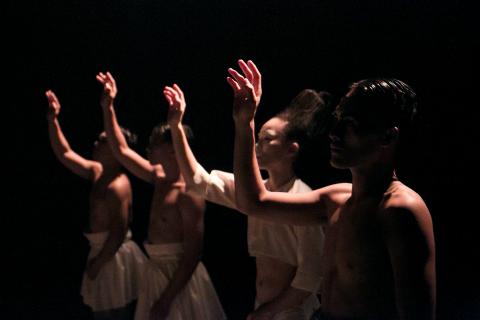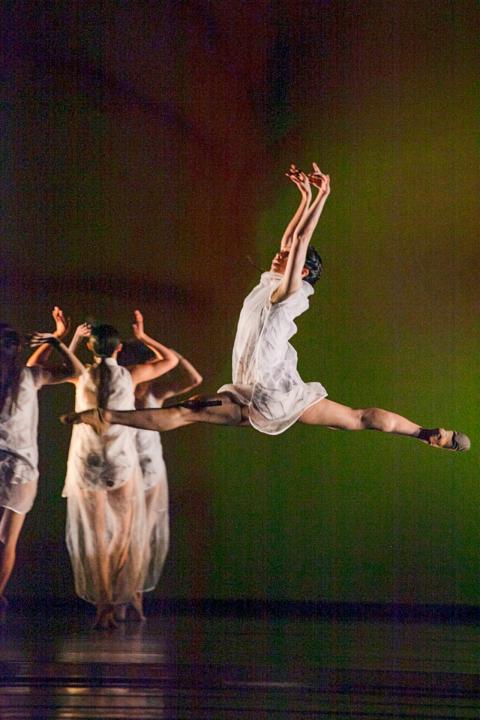It was a year with plenty of highs and a few lows — and plenty of weekends when Taipei’s dance audiences were overloaded with choices, so selecting the truly outstanding shows was a tough job and it proved impossible to see everything.
It was also a year of unexpected surprises, and one that proved very good for the nation’s mid-sized choreographers and companies as well as the National Theater Concert Hall (NTCH), where the annual Taiwan International Festival of Arts won at lot of applause.
The biggest surprise came in early June, when choreographer Kader Attou’s Compagnie Accrorap made its Taiwan premiere at the National Sun Yat-sen Memorial Hall with Attou’s 2013 production, The Roots. I am embarrassed to admit my bias was showing when I turned up for the 70-minute hip-hop piece; I was not expecting a lot and ended up being blown away.

Photo courtesy of Tjimur Dance Theatre
The Roots grabs viewers’ attention from the opening scene and Attou’s creativity, the fluidity of his 11 male dancers, as well as a beautiful score by Regis Baillet-Diaphane all made for a terrific show — even if it seemed a tad too long — and left me longing to see more of Attou’s works.
One of the best works of the year was Leipzig Ballet artistic director and choreographer Mario Schroder’s Wild Butterflies (狂放的野蝶), created for Century Contemporary Dance Company (CCDC, 世紀當代舞團) as part of a joint program for the NTCH festival in April. The show included a revival of CCDC founder Yao Shu-fen’s (姚淑芬) powerful Les Noces (婚禮) and an extract of Schroder’s Ein Liebestraum (A Dream of Love) performed by his Leipzig dancers. Wild Butterflies (狂放的野蝶) owed its power to both Schroder’s choreography and to the beautiful videography of Chang Hao-jan (張皓然).
It was a good year for Dance Forum Taipei (舞蹈空間), whose third collaboration with Spanish choreographer Marina Mascarell, it is like a large animal deep in sleep (沉睡的巨獸), was another winner. The show at Huashan 1914 Culture Park in mid-May featured a multitude of cardboard boxes and posed a lot of questions, but it proved as entertaining as it was thought provoking.

Photo courtesy of National Theater Concert Hall
The troupe’s second joint production, Hui (迴) — a collaboration with Amsterdam-based Anmaro Asia Arts, Glasgow-based Cryptic, New York City-based Chinese composer Tan Dun (譚盾), Taiwanese choreographer Yang Ming-lung (楊銘隆) and Netherlands-based Spanish choreographer Ivan Perez Aviles — was visually stunning, but not as cohesive or strong as Mascarell’s piece.
However, hers had the benefit of having “marinated” for several months, having begun life as a three-dancer piece for Skanes Dansteater last year, which raises hopes that Hui reaches its full potential when it goes on a scheduled tour in Europe in 2017.
Among the other highlights was Cloud Gate 2’s (雲門 2) Spring Riot program: Horde (暫時而已) by Huang Huai-te (黃懷德), Hell Groove (衝撞天堂) by Chen Yun-ju (陳韻如) and artistic director Cheng Tsung-lung’s (鄭宗龍) Beckoning (來) at the new Cloud Gate Theater/Tamsui Culture and Art Education Center (淡水文化藝術教育中心) in New Taipei City’s Tamsui District (淡水) were all good works and the troupe looked better than ever.
Cloud Gate 2’s first resident choreographer, Bulareyaung Pagarlava, made a strong showing with his new Taitung-based troupe, the Bulareyaung Dance Company (布拉瑞揚舞團台北首演), at the Tamsui venue with La Ke (拉歌) in July.
Ho Hsiao-mei’s (何曉玫) Camouflage (假裝) at the National Theater in June was great, with an innovative set and stage design that took full advantage of the big stage to show her Meimage Dance (玫舞擊) troupe to their best advantage. It is a piece I would love to see again, as was T.T.C. Dance’s (張婷婷獨立製作) Body Platform: Persistence of Memory (肢‧色系列2:時空抽屜) show at the Experimental Theater in August. Despite the cramped space, Chang Ting-ting (張婷婷) made use of an unusual set that helped blur the boundaries between her dancers and 3D projections.
Just when Taipei dance fans might have thought they had seen everything, last weekend produced two final delights, both from southern Taiwan. It was good to see Benson Tsai’s (蔡博丞) new B.DANCE (丞舞製作團隊) troupe at the Shuiyuan (Wellspring) Theater and his attempt at a full-length piece, but as fun as Floating Flowers II (浮花) was to watch, it needs trimming because it is too reliant upon a driving score and pop-art videography to keep the audience’s interest.
However, Tjimur Dance Theatre’s (蒂摩爾古薪舞集) 似不舞[s] (As Four Step) at the Experimental Theater proved the power and beauty of simplicity. Baru Madiljin’s minimalist choreography is highlighted by simple white costumes and monochromatic staging, and the piece was simply wonderful to watch. My only complaint is that the show was the first time I had ever seen the nine-year-old company and now I know just how much I have been missing.
It was also a year to say a very unwilling goodbye. The magnificent French dancer Sylvie Guillem, whose “Life in Progress” tour closes the door on her storied career as of today, thankfully added two Taipei dates to her already full schedule, and she was as amazing and mesmerizing as ever.

This is the year that the demographic crisis will begin to impact people’s lives. This will create pressures on treatment and hiring of foreigners. Regardless of whatever technological breakthroughs happen, the real value will come from digesting and productively applying existing technologies in new and creative ways. INTRODUCING BASIC SERVICES BREAKDOWNS At some point soon, we will begin to witness a breakdown in basic services. Initially, it will be limited and sporadic, but the frequency and newsworthiness of the incidents will only continue to accelerate dramatically in the coming years. Here in central Taiwan, many basic services are severely understaffed, and

It is a soulful folk song, filled with feeling and history: A love-stricken young man tells God about his hopes and dreams of happiness. Generations of Uighurs, the Turkic ethnic minority in China’s Xinjiang region, have played it at parties and weddings. But today, if they download it, play it or share it online, they risk ending up in prison. Besh pede, a popular Uighur folk ballad, is among dozens of Uighur-language songs that have been deemed “problematic” by Xinjiang authorities, according to a recording of a meeting held by police and other local officials in the historic city of Kashgar in

Jan. 5 to Jan. 11 Of the more than 3,000km of sugar railway that once criss-crossed central and southern Taiwan, just 16.1km remain in operation today. By the time Dafydd Fell began photographing the network in earnest in 1994, it was already well past its heyday. The system had been significantly cut back, leaving behind abandoned stations, rusting rolling stock and crumbling facilities. This reduction continued during the five years of his documentation, adding urgency to his task. As passenger services had already ceased by then, Fell had to wait for the sugarcane harvest season each year, which typically ran from

The People’s Republic of China (PRC) was out in force in the Taiwan Strait this week, threatening Taiwan with live-fire exercises, aircraft incursions and tedious claims to ownership. The reaction to the PRC’s blockade and decapitation strike exercises offer numerous lessons, if only we are willing to be taught. Reading the commentary on PRC behavior is like reading Bible interpretation across a range of Christian denominations: the text is recast to mean what the interpreter wants it to mean. Many PRC believers contended that the drills, obviously scheduled in advance, were aimed at the recent arms offer to Taiwan by the